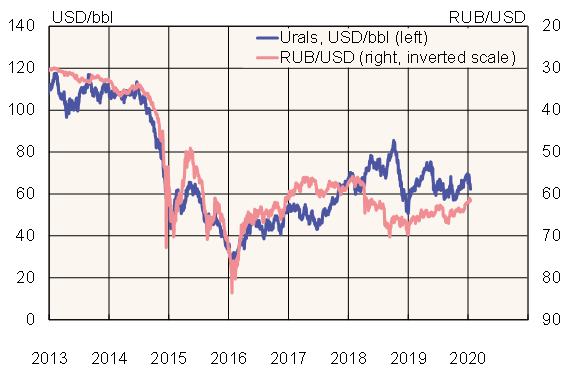BOFIT Weekly Review 03/2020
Ruble appreciation continues in the first two weeks of this year
The ruble’s exchange rate has appreciated gradually since its lows at the end of 2018. Over the first weeks of this year, the average dollar exchange rate has been around 62 rubles, while the euro rate has hovered around 69 rubles. The ruble has gained about 10 % against both currencies over the past 12 months. Even so, the ruble’s exchange rate is still considerably weaker than at its peak in early 2018.
Rising oil prices have helped lift the ruble as they increase Russian export earnings and boost capital flows into the country. The price of Urals-grade crude in the first weeks of this year has averaged around 66 dollars a barrel, which is about 15 % higher than a year ago. The effect of oil prices is, however, restricted by the currency purchases conducted by the Central Bank of Russia for the finance ministry in accordance with the government’s fiscal rule. The link between oil prices and the ruble’s exchange rate seems to have weakened in recent years.
The ruble’s real appreciation against the dollar and euro has been slightly more than its nominal appreciation. While inflation slowed in Russia at the end of last year, falling to just 3 % p.a. in December, it was still higher than in either the euro zone or the United States. The ruble’s real effective (trade-weighted) exchange rate, or REER, rose by 8 % over the course of 2019.
The ruble’s appreciation is generally not expected to continue this year, however. Most analysts expect the exchange rate to average around 65 rubles to the dollar this year. The finance ministry’s forecast, the basis of the Russian budget’s exchange rate assumption, expects the ruble-dollar rate to average 65.7 this year.
Ruble-dollar exchange rate and Urals oil price

Source: Reuters.